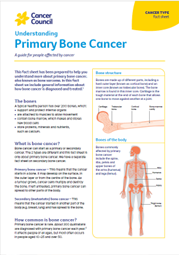Primary bone cancer
If you’re affected by primary bone cancer (bone sarcoma), you may have many questions about how it is diagnosed, treatment options, side effects and how to stay well. You can find trustworthy information about all aspects of your experience below.

This checklist may be helpful when thinking about questions to ask your doctor.
- What type of bone cancer do I have?
- What treatment do you recommend and why?
- How can I find a specialist treatment centre?
- What is the prognosis?
- If I have surgery, what are the side effects?
- Do I need an amputation?
- If I have to travel for treatment, is there any government funding available to help with the cost?
- Are there any clinical trials I could join?
- If the cancer has spread outside the bone, what treatment options are available for me?
- How often will I need check-ups after treatment?
- If the cancer comes back, how will I know?
For information on cancer that has started in another part of the body and spread to the bone (bone metastases), see secondary bone cancer.
Need to talk?
All updated content has been clinically reviewed by Prof Peter Choong AO, Orthopaedic Surgeon, and Sir Hugh Devine Professor, St Vincent’s Hospital, and Head of Department of Surgery, The University of Melbourne, VIC. This edition is based on the previous edition, which was reviewed by the following panel: Prof Peter Choong AO (see above); Catherine Chapman, Adolescent and Young Adult and Sarcoma Cancer Specialist Nurse, Division of Cancer and Ambulatory Support, Canberra Hospital, ACT; A/Prof Paul Craft AM, Medical Oncologist, Canberra Hospital and Australian National University, ACT; Belinda Fowlie, Bone Tumour Nurse Practitioner Candidate, SA Bone and Soft Tissue Tumour Unit, Flinders Medical Centre, SA; Prof Angela Hong, Radiation Oncologist, Chris O’Brien Lifehouse, and Clinical Professor, The University of Sydney, NSW; Vicki Moss, Nurse Practitioner, SA Bone and Soft Tissue Tumour Unit, Flinders Medical Centre, SA; A/Prof and Dr Marianne Phillips, Paediatric and Adolescent Oncologist and Palliative Care Physician, Perth Children’s Hospital, WA; Chris Sibthorpe, 13 11 20 Consultant, Cancer Council Queensland; Stephanie Webster, Consumer. We would also like to thank the health professionals and consumers who have worked on previous versions of this information.
View the Cancer Council NSW editorial policy.